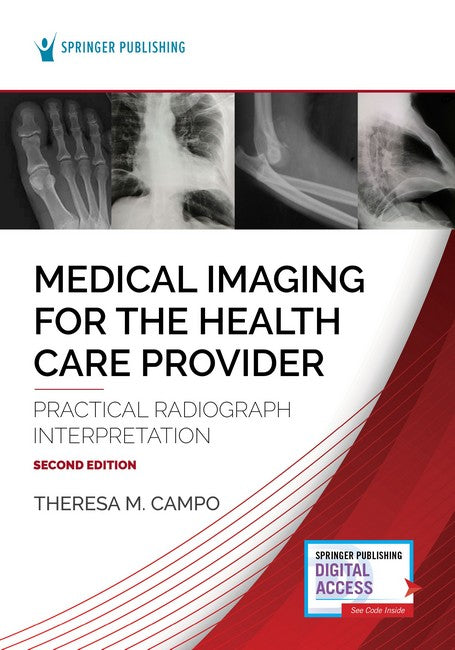Description
Reviewers Foreword by David Begleiter, MD Preface Acknowledgements Springer Publishing ConnectTM Resources SECTION I: INTRODUCTION TO MEDICAL IMAGING INCLUDING RADIOGRAPHS, CT, NUCLEAR SCANS, MRIS, AND ULTRASONOGRAPHY Chapter 1. Radiology Basics, History of Radiology Factors Affecting Images Conclusion Resources Chapter 2. Radiating Testing Modalities Radiographs Computer Tomography (CT) Nuclear Scanning Conclusion Resources Chapter 3. Nonradiating Testing Modalities Magnetic Resonance Imaging (MRI) Ultrasonography Considerations When Ordering Diagnostic Medical Imaging Conclusion Resources SECTION II: INTERPRETING CHEST AND ABDOMINAL RADIOGRAPHS Chapter 4. Basic Interpretation of the Chest Radiographic Densities Adequacy of Radiographs Pediatric Considerations (Comparison of Adult and Infant/Child) Mediastinal Width Conclusion Resources Chapter 5. Abnormalities Found on Radiographs of the Chest Atelectasis Pulmonary Edema Pleural Effusion Interpretation of Infiltrates and Consolidation Pneumothorax Tension Pneumothorax Pneumomediastinum Hyperaeration Masses and Tumors Conclusion Resources Chapter 6. Basic Interpretation of the Abdomen Interpretation and Normal Findings Free Air and Air-Fluid Levels Calcifications Foreign Bodies Dilated Small Bowel Dilated Large Bowel and Megacolon Conclusion Resources SECTION III: INTERPRETATION OF EXTREMITY RADIOGRAPHS Chapter 7. Basic Interpretation of Long Bone--Upper Extremity Radiographs Normal Abnormalities of the Upper Extremity Bone Lesions Conclusion Resources Chapter 8. Basic Interpretation of Long Bone--Lower Extremity Radiographs Normal Describing Fractures Pediatric Considerations Abnormalities of the Lower Extremity Conclusion Resources SECTION IV: INTERPRETATION OF SPINE RADIOGRAPHS Chapter 9. Basic Interpretation of Cervical Spine Radiographs Normal Abnormalities Conclusion Resources Chapter 10. Basic Interpretation of Thoracic Spine Radiographs Normal Abnormalities Conclusion Resources Chapter 11. Basic Interpretation of Lumbar Spine Radiographs Normal Abnormalities Conclusion Resources Index
Theresa M Campo DNP, APRN, FAANP, FAAN is Chair of the Department of Emergency Medical Services (EMS) and the Director of the Emergency Nurse Practitioner Track as well as Associate Clinical Professor at Drexel University. Clinically, she is board certified as a Family Nurse Practitioner and Emergency Nurse Practitioner, and works part-time as a nurse practitioner in Southern New Jersey.Theresa received her Doctor of Nursing Practice from Case Western Reserve University in Cleveland, Ohio. She earned her Master of Science in Nursing, Family Nurse Practitioner, from Widener University in Chester Pennsylvania. Theresa has over 30 years of experience in emergency medicine, including pre-hospital, emergency department/quick care, and trauma. Dr. Campo is a founding Board Member of the American Academy of Emergency Nurse Practitioners, a national organization. She is a national and international lecturer on emergency and urgent care topics. Dr. Campo is the Author of Medical Imaging for the Health Care Provider: Practical Radiograph Interpretation and has authored several book chapters and peer-reviewed articles. Theresa was inducted as a Fellow of the American Association of Nurse Practitioners (AANP) in 2015 and Fellow of the American Academy of Nursing in 2017. She has received the alumni award for excellence from Case Western Reserve University and the state award of excellence from AANP.

